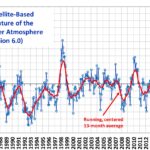Het VN-klimaatfonds van $ 100 miljard per jaar was het enige ‘succes’ van de klimaattop in Kopenhagen in 2009, die voor het overige in een fiasco eindigde. Hoe staat het daar nu mee na het ‘succes’ van de Klimaattop van Parijs van 2015?
Onlangs maakte de voorlichtingsdienst van de Europese Raad bekend dat de EU en haar lidstaten in 2015 €17.6 miljard klimaathulp hadden toegezegd.
Ik citeer:
Climate finance: EU and member states’ contributions up to €17.6 billion in 2015.
Contributions from the EU and its member states to help developing countries reduce their greenhouse gas emissions and cope with the impacts of climate change showed a sharp increase in 2015, particularly for adaptation finance.
The total was confirmed on 24 October 2016 at a meeting of the EU Economic and Financial Committee, ahead of a UN climate change conference in Marrakesh.
Total contributions from the EU and its member states amounted to €17.6 billion in 2015, a significant increase compared to 2014. The contributions were successfully channelled into climate change mitigation and adaptation initiatives in developing countries.
The contribution is seen as an important step towards the implementation of the legally binding climate change agreement reached in Paris in December 2015. [Noot HL: Dit is een voorbeeld van stelselmatige desinformatie. De overeenkomst was niet bindend.]
The latest figure demonstrates the EU’s determination to scale up its international climate finance contribution towards the $100 billion per year goal set for industrialised countries by 2020 and through until 2025. Before 2025, the parties to the UN framework convention on climate change will set a new collective goal. …
Lees verder hier.
Kortom de EU-klimaatpropaganda lijkt te suggereren dat wij goed op weg zijn naar het halen van de doelstelling van $ 100 miljard per jaar. Hoe anders en nuchterder was de teneur van een recente ‘posting’ die op de website van ‘The American Interest’ verscheen.
Ik citeer:
Smart Spending? Climate Fund Still Can’t Get Off the Ground.
The UN’s Green Climate Fund (GCF) was the one “success” to emerge from the disastrous 2009 Copenhagen climate summit, and as envisioned it would raise funds from wealthy countries to spend on projects that would help poorer countries mitigate and adapt to climate change. The GCF is the singular carrot that helped get the developing world on board with the non-binding deal agreed upon in Paris this past December, but thus far it has failed completely to follow through on its only two tasks: raising money, and then spending it.
The GCF was expected to bring in $100 billion annually, but thus far has only accrued a little over $10 billion. That, however, isn’t the failure that’s making the news today. That’s because the fund is finding it surprisingly difficult to spend the money it’s managed to raise. As Reuters reports, the GCF is going to miss this year’s spending goal by more than $1 billion:
The Green Climate Fund (GCF) board, meeting at its headquarters in South Korea, approved funds for 10 projects including geothermal energy in Caribbean nations, controlling flood risks from melting glaciers in Pakistan, and green energy in sub-Saharan Africa. The new funding raised the GCF total of approved projects so far in 2016 to about $1 billion, well behind schedule to realize the $2.5 billion target for its first full year of operation.
“We may not get there, we don’t know. But we think it’s important to have an aspiration,” Ewen McDonald of Australia, a co-chair of the GCF board, told Reuters after the board meeting in reference to the target.
The GCF board’s co-chair seems content to keep his organization’s goals aspirational, and that ought to send a chill up the spine of each and every developing world country’s climate delegate. If that defeatist attitude is representative of the culture of the GCF—a group that has already been described as under-staffed and over-stretched—then it’s hard to see the fund gaining any sort of traction even after it falls well short of this year’s targets.
Spending this money intelligently, and ensuring the UN has the proper oversight in place to make sure the projects funded are doing what they were meant to, is no easy task. It says something significant that coming up with $100 billion every year might not be the most pressing problem for the Green Climate Fund at the moment.
Lees verder hier.
Het blijft moeilijk om door de bomen van de desinformatie nog zicht te houden op het bos.
De EU staat bekend om het overdrijven van haar eigen vrijgevigheid. Ik vermoed dat het verschil tussen beide berichten moet worden verklaard uit het onderscheid tussen ‘commitments’ (toezeggingen) en ‘disbursements’ (betalingen). De betalingen lopen gewoonlijk achter bij de toezeggingen – soms wel vele jaren. En sommige toezeggingen worden nooit gehonoreerd. Daar horen we gewoonlijk nooit meer wat over. Soms is dat triest. In dit geval lijkt het mij gelukkig.
Voor mijn eerdere bijdragen over klimaat en aanverwante zaken zie hier, hier, hier, hier en hier.






Een zinnig mens kijkt naar die cijfers en kan amper zijn ogen geloven. Hoe ernstig moet Groen van de ratten besnuffeld zijn om dergelijke krankzinnige bedragen als overwinning te beschouwen, terwijl ze niets anders zijn dan donaties aan het Eco Industrieel Complex (bijv. Al Gore) vanwege een hersenspinsel dat AGW-hypothese heet. En dezulken durven te spreken over het voor een tribunaal dagen van sceptici. Die hebzuchtige klimaatsultans moesten zich schamen.
Het klimaatgedoe doet mij denken aan lege vaten.
Een hoop kabaal, veel geschreeuw en weinig wol.
Ik heb gezocht naar exacte bedragen van Nederland
in 2015 aan bijdragen aan het VN klimaat verdrag
maar kwam niet verder dan wollig taalgebruik.
Ik heb nog nooit wol op een vat zien groeien, ook niet op een vol vat.
Hoezo wollig taalgebruik?
:-)